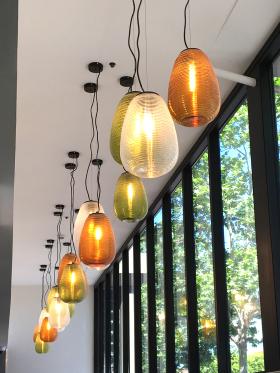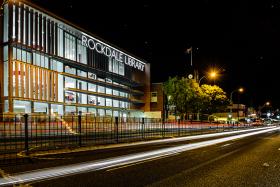Features and considerations: Lighting
The lighting design in a library has a huge impact on the functionality of the space as well as the ambience. Lighting design is as much about the quality of light (and dark) as it is about the appropriate level of light.
Lighting within libraries should firstly offer a range of spaces and settings for different activities, and secondly can empower the visitor with a limited degree of personal control where the lighting conditions may be modified by the individual. In this way the lighting should complement the architecture and interior design so that themes and elements are accentuated, and the control should be intuitive to use. The aim is also to create a degree of control and flexibility between daylight and artificial lighting. Information on natural light is in the Sustainability section of People Places.
Lighting techniques
The general rule of thumb for library lighting design is to provide light of even intensity and distribution for lighting shelves and task surfaces. Conversely, flooding all interiors with light can result in a clinical and unfriendly environment. The aim should be to create comfortable and welcoming spaces.

Maximise lighting efficiency
Ceiling and wall surfaces are usually light reflecting rather than light absorbing to maximise light reflections – this does not mean that all library building surfaces should be uniformly light in colour.
Bring the light source close to where it is required
An example is task lighting. This avoids inefficient lighting of space – additional localised task lighting may be required at locations such as study desks and reading chairs.
Ensure that lighting and shelving are carefully related
This ensures that readers are not standing in their own light.
Ensure accessibility to light fittings
Not too high, easily maintained and easily cleaned.
Ensure a clear maintenance regime
One must be provided before the design is approved for documentation.
Choose a luminaire
A luminaire is the lamp or globe within the light fitting. Consider its energy efficiency, the hue of the projected light, the resulting colour of objects which it illuminates (colour rendering), its ability to dim if required and its availability to be replaced.
Highlight focal points
Check that focal points in the library are highlighted by lighting design, such as displays and service points.
Provide feature lighting
This adds to the visual impact of the building after dark as well as defining specific interior functions.
Adjust lighting for specific areas
Consider the level of light (or lighting control) provided to areas where projected images may be used.
Consider mood lighting effects
Consider softer lighting effects, even darker spaces, such as creating moods in story time rooms, where strong task lighting or shelf lighting is not required.
Consider lighting control
Adjust lights in various zones through lighting control systems, light sensors or simply being able to turn off lights in each space will significantly reduce power consumption and increase user comfort; ensure that lighting control systems are easy to use.
Provide flexible lighting options
Lighting needs to be considered in relation to movable furniture and potential changes in layout. Flexible ceiling grids can offer greater flexibility in both lighting and cabling for power/communications and other functional requirements such as suspension of banners and signage. Lighting can also be built into furniture and demountable walls to make it easier to locate where needed.
Lighting standards
Recommended lighting standards for public libraries are as follows:
- 100 Lux: for closed areas such as stacks. Illuminance should be measured at floor level.
- 300 Lux: for workrooms, foyers, staff rooms, washrooms, lounges, offices. To be measured at desk height.
- 400 Lux: for all other areas, such as public lending areas, reference sections, counters, readers advisory desks. To be measured at desk height.
A lighting engineer, who is often an integral member of the building design team, can provide specialist input. Elsewhere lighting should comply with the Building Code of Australia and Australian Standard 1680: Interior and workplace lighting.
Exterior lighting

The exterior lighting of the library and its surroundings should display the building during the hours of darkness in a flattering way and accentuate the architecture. The overall effect should be considered as well as the enhancement of the public realm. A public library is used when its readers find it convenient, which in many instances means evening and after-dark.
The lighting around the library should create an inviting atmosphere where people feel safe, and with the trend towards free Wi-Fi potentially wanting to use the adjacent areas outside of library opening hours. Lighting design should assist in avoiding/mitigating unsafe areas which may lead to entrapment or property damage.